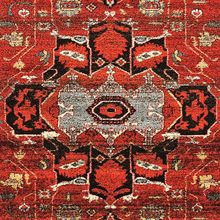Goravan Rug
| Goravan Rug | |
|---|---|
 Design of Goravan Rug (Rugman) | |
| General information | |
| Name | Goravan Rug |
| Original name | قالی گراوان |
| Alternative name(s) | Goravan Carpet |
| Origin | |
| Category | Village |
| Technical information | |
| Common designs | Lachak Toranj, Geometric |
| Common colors | Blue, Red, Beige |
| Dyeing method | Natural, Synthetic |
| Pile material | Wool |
| Foundation material | Cotton |
| Knot type | Symmetrical (Turkish) |
Goravan rugs are hand woven in the East Azerbaijan Province of northwestern Iran in close proximity to Heriz. The design, color, and quality of a Persian carpet from Goravan is so entirely identical to a Persian carpet from Heriz, that even experts in the field have great difficulty telling them apart. Although Heriz is the better known area, a Persian carpet woven in Goravan is every bit its equal. Typically, Goravan rugs are woven with a special symmetrical double knot that is dense and tightly packed.
History
Goravan is a village located near the famous weaving town of HERIZ in the East Azerbaijan Province of northwestern Iran. The population is Azeri tribe in origin, and they speak a Turkic dialect. Goravan carpets are woven in the Heriz design style and are grouped under the Heriz carpet name. Production in Goravan began when the demand for Heriz carpets grew in the world marketplace during the early twentieth century. Goravan carpets are known in the market from the 1900s.
Goravan carpets can be identified from other weaves in the Heriz group by their lower grade quality, which met the need in the market for lower- budget domestic and foreign consumers. After World War II a great quantity of Goravan carpets was produced for export to the world markets.[1]
Materials
Foundation and Pile
The Goravan rugs and carpets have a cotton foundation and a wool pile.[2]
Techniques and structures
Color and dyeing
The coloration Goravan rugs, in general, is a deep red for the background and dark blue for the border. In addition, reds, blues, ivory, cinnamon, camel, and browns are used in the design elements. Dark brown or black is used for die design outlines.[3]
The colors on Goravan rugs are created from root and vegetable dyes. Newer carpets may use different color combinations such as light red and brown, with baby blue as the contrasting shade.
Motifs and Designs
Goravan carpet designs are geometric, with either a medallion or an allover style. In general these carpets are well known for having a large center medallion with medallion sections in the corners. The designs feature large stylized palmettes, leaves, and vines with primitive nomadic motifs and ornaments. Starting in the 1920s the Heriz carpet fashion was to crowd the field with various design motifs; Goravan weavers also followed this practice.[4]
Weaving techniques
The Goravan rugs is used The Turkish (symmetric) knot. The formats range from small mats to carpets approximately fourteen feet by ten feet. A majority of Goravan weavings were made in the standard twelve feet by nine feet format for the American market. Goravan carpets are medium in grade quality.[5]
See also
| Search for Goravan Rug on Wikipedia. |
References
Bibliography
- Abraham Levi Moheban, (2015), The Encyclopedia of Antique Carpets: Twenty-Five Centuries of Weaving, NewYork: Princeton Architectural Press.
- JOZAN: Rug news and antique rugs.
